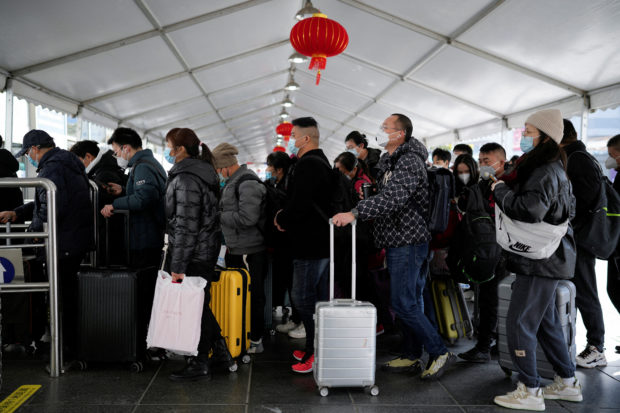Millions of Chinese workers on the move ahead of Friday travel peak

People walk with their luggage at a railway station during the annual Spring Festival travel rush ahead of the Chinese Lunar New Year, as the coronavirus disease (COVID-19) outbreak continues, in Shanghai, China January 16, 2023. REUTERS FILE PHOTO
BEIJING — Millions of urban workers were on the move across China on Wednesday ahead of the expected Friday peak of its Lunar New Year mass migration, as China’s leaders looked to get its COVID-battered economy moving.
Unfettered when officials last month ended three years of some of the world’s tightest COVID-19 restrictions, workers streamed into railway stations and airports to head to smaller towns and rural homes, sparking fears of a broadening virus outbreak.
Economists are scrutinizing the holiday season, known as the Spring Festival, for glimmers of rebounding consumption across the world’s second largest economy after new GDP data on Tuesday confirmed a sharp economic slowdown in China.
While some analysts expect that recovery to be slow, China’s Vice-Premier Liu He declared to the World Economic Forum in Switzerland on Tuesday that China was open to the world after three years of pandemic isolation.
National Immigration Administration officials said that, on average, half a million people had been moved in or out of China per day since its borders opened on Jan. 8, state media reported.
Article continues after this advertisementBut as workers flood out of megacities, such as Shanghai, where officials say the virus has peaked, many are heading to towns and villages where unvaccinated elderly have yet to be exposed to COVID and health care systems are less equipped.
Article continues after this advertisementLarge, rolling suitcases, boxes of gifts
As the COVID surge intensified, some were putting the virus out of their mind as they headed for the departure gates.
Travellers bustled through railway stations and subways in Beijing and Shanghai, many ferrying large wheeled suitcases and boxes stuffed with food and gifts.
“I used to be a little worried (about the COVID-19 epidemic),” said migrant worker Jiang Zhiguang, waiting among the crowds at Shanghai’s Hongqiao Railway Station.
“Now it doesn’t matter anymore. Now it’s okay if you get infected. You’ll just be sick for two days only,” Jiang, aged 30, told Reuters.
The infection rate in the southern city of Guangzhou, capital of China’s most populous province, has now passed 85%, local health officials announced on Wednesday.
In more isolated areas, state medical workers are this week going door-to-door in some outlying villages to vaccinate the elderly, with the official Xinhua news agency describing the effort on Tuesday as the “last mile”.
Clinics in rural villages and towns are now being fitted with oxygenators, and medical vehicles have also been deployed to isolated areas.
While authorities confirmed on Saturday a huge increase in deaths – announcing that nearly 60,000 people with COVID had died in hospitals between Dec. 8 and Jan. 12 – state media reported that heath officials were not yet ready to give the World Health Organization (WHO) the extra data it is now seeking.
Specifically, the U.N. agency wants information on so-called excess mortality – the number of all deaths beyond the norm during a crisis, the WHO said in a statement to Reuters on Tuesday.
The Global Times, a nationalistic tabloid published by the official People’s Daily, quoted Chinese experts saying the China Center for Disease Control and Prevention was already monitoring such data, but it would take time before it could be released.
Doctors in both public and private hospitals were being actively discouraged from attributing deaths to COVID, Reuters reported on Tuesday.
RELATED STORIES
China’s Lunar New Year travel offers spark of economic rebound from COVID crunch
China’s on the move again, economic outlook brightens
For more news about the novel coronavirus click here.
What you need to know about Coronavirus.
For more information on COVID-19, call the DOH Hotline: (02) 86517800 local 1149/1150.
The Inquirer Foundation supports our healthcare frontliners and is still accepting cash donations to be deposited at Banco de Oro (BDO) current account #007960018860 or donate through PayMaya using this link.